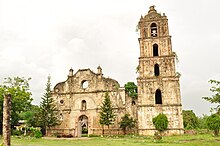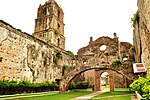Church in Isabela, Philippines
| San Pablo Church | |
|---|---|
 The church ruins in 2013 The church ruins in 2013 | |
  | |
| 17°26′54″N 121°47′37″E / 17.44833°N 121.79361°E / 17.44833; 121.79361 | |
| Location | San Pablo, Isabela |
| Country | Philippines |
| Denomination | Roman Catholic |
| History | |
| Status | Ruins |
| Architecture | |
| Functional status | Inactive |
| Heritage designation | National Cultural Treasure |
| Architectural type | Church building |
| Style | Baroque |
| Completed | 1624; 401 years ago (1624) |
San Pablo Church is ruined Roman Catholic church located in San Pablo, Isabela, Philippines. The church was built in 1624, making it the oldest in Isabela.
History
The church was damaged during World War II. In 1949, it was destroyed by the 7-magnitude earthquake that hit the Cagayan Valley, and its roof was burned down in the 1950s. Unable to renovate, a smaller church, one-third the size of San Pablo Church, was built inside the walls.
Present situation
Fronting the church is a patio overgrown with grass. Still standing is the church's facade, with visible bas-relief and religious icons on each side. The church's arched main entrance, vigil room, support for the choir loft, and buttresses, which continue to support the structure, are still visible.
Diggings of sacred grounds, through the ancient walls and a tunnel toward the church's altar, were reportedly conducted by people looking for the Yamashita's treasure.
The National Museum of the Philippines declared the church as a national cultural treasure.
Architecture
The Baroque-styled church was constructed using bricks mixed with riverstones, adobe and coral stones. Its belfry of six layers, including the circular apex made of adobe, was the tallest in the Cagayan Valley.
Gallery
References
- ^ "San Pablo Church: Weathering the test of time at 300". The Northern Forum. November 5, 2016. Retrieved February 14, 2024.
- Begas, Billy (July 2, 2021). "For DOT's priority: House panels OK declaration of San Pablo Church as tourist site". Politiko. Retrieved February 14, 2024.
- ^ "7 Churches to Visit in Cagayan Valley During Holy Week". 7641 Islands of the Philippines. Retrieved February 14, 2024.
- Layug, Benjamin (February 13, 2020). "Discover Bella Isabela". BusinessMirror. Retrieved February 14, 2024.
- ^ Tejero, Constantino (March 18, 2015). "Tumauini Church of Isabela stands proud amid fragile heritage scene". Philippine Daily Inquirer. p. C1. Retrieved February 14, 2024 – via PressReader.com.
- Vallejo, Susan (November 2018). "Assessment of Heritage Churches in Isabela, Cagayan Valley" (PDF). International Journal of Scientific Engineering and Research (IJSER). 6 (11): 135–139 – via IJSER.
- Sembrano, Edgar Allan M. (May 29, 2022). "Philippine patrimony: National cultural treasures list revealed". Lifestyle.INQ. Retrieved February 14, 2024.
- Tejero, Constantino (October 19, 2014). "Isabela uncovered". Philippine Daily Inquirer. p. E1. Retrieved February 14, 2024 – via PressReader.com.
- Isabela Tourism Office (March 23, 2001). "Historical Development of the Province of Isabela" (PDF). Retrieved February 14, 2024 – via provinceofisabela.ph.
External links
- [REDACTED] Media related to Saint Paul of Cabagan Church (San Pablo, Isabela) at Wikimedia Commons


